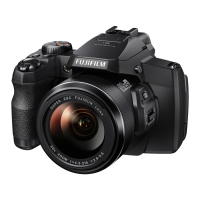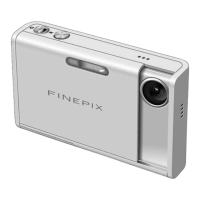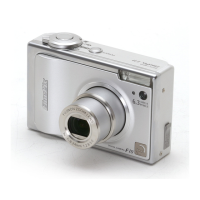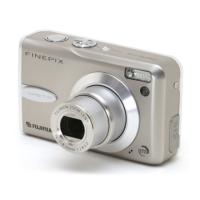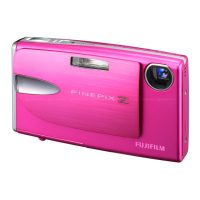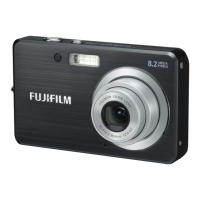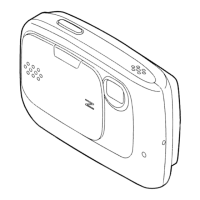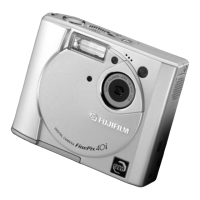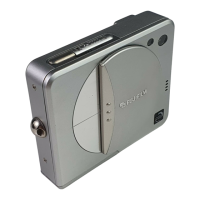Do you have a question about the FujiFilm FinePix M603 and is the answer not in the manual?
Warning about fire/shock risks from moisture and improper handling.
Icon indicating important operating and maintenance instructions.
FCC statement for US and Canadian compliance information.
Importance of test shots for important photos and liability.
Rules for using recorded images and copyright restrictions.
Precautions if liquid crystal from the LCD monitor is exposed.
Warnings about interference and camera handling precautions.
List of trademarks and TV system explanations.
Explanation of Exif Print format for optimal printing.
Details on NP-60/NP-120 batteries, charger, and AC adapter.
Information on A/V cable, USB set, and LCD monitor hood.
Details on Handgrip and camera strap accessories.
Identification of buttons and switches on the camera body.
Explanation of icons displayed in still photography mode.
Explanation of icons displayed in playback mode.
Information on compatible NP-60 and NP-120 batteries.
Steps for inserting and charging the battery.
Overview of media types and compatibility.
Steps for inserting and removing media cards.
Instructions for charging via AC adapter.
How to turn the camera on/off; lens cover operation.
Procedure for setting camera's date and time initially.
How to change the format for displaying the date.
Identification and function of key camera buttons.
Explanation of modes: Still, Playback, Movie.
How to open and use the camera's menu system.
Proper grip and support to prevent camera shake.
Technique for pressing the shutter button to focus and shoot.
Steps to turn on camera and select Auto mode.
Using LCD and AF frame for composition.
How AF/AE lock works and its benefits.
Explanation of indicator lamp lights and their meanings.
Interpreting battery level indicators.
How the power save feature works.
Subjects/conditions where autofocus may struggle.
Shots fitting on different media types.
How to use optical and digital zoom.
Using framing guidelines for composition.
How to activate and use Macro mode.
Explanation of different flash modes.
Default flash mode that fires automatically.
Minimizing red-eye effect in portraits.
Using flash in bright/dark conditions and slow shutter speed.
Using flash for indoor or specific venues.
How to view individual images.
Quickly scanning and viewing multiple images.
How to zoom in on movies and pan the view.
Saving a frame from a movie as a still image.
Procedures for deleting individual or all files.
How to open and use the camera's menu system.
Overview of available settings in different modes.
Description of Auto mode for simple shooting.
Description of Manual mode for precise settings.
Choosing quality settings for prints or web use.
Limits when using high ISO with certain quality settings.
How to set up and use the self-timer.
How the self-timer countdown and lamp work.
Shooting up to 4 frames rapidly, showing results sequentially.
Capturing the last 4 frames of a burst sequence.
Shooting up to 40 frames at longer intervals.
Important notes on focus, exposure, and flash usage.
Capturing preceding video with a still image.
Battery considerations and power save exceptions.
How to activate and use the preview movie feature.
Changing ISO for low light or fast shutter.
Impact of high ISO on image quality.
Adjusting brightness for subjects brighter/darker than background.
Adjusting color temp for different lighting.
Starting movie shooting; available formats.
Estimated shooting times for media capacities.
Using zoom and how focus adjusts automatically.
Display of remaining recording time.
Points on sound recording and lens noise.
Settings for movie frame sizes and rates.
Scenes/subjects not suited for movie recording.
Options to erase, protect, and set up DPOF prints.
Recording/playing voice memos and automatic image playback.
Erasing files, formatting media, and image protection.
Setting DPOF prints and managing voice notes.
Selecting images and print quantity for DPOF.
Option to imprint dates on printed photos.
Completing the DPOF setup process.
Procedure to attach voice notes to still images.
Steps for recording and saving a voice memo.
Option to rerecord or manage existing voice notes.
Finding and playing images with voice notes.
Controls for playback, pause, stop, and fast forward/rewind.
How to enable automatic image playback.
What happens during auto playback and how to stop it.
How to choose and play movie files.
Controls for playback, pause, stop, and skip.
Using controls to adjust playback speed.
Available speeds for playback adjustments.
How to zoom in/out on movies when paused.
How to pan around the zoomed movie image.
Selecting start/end points to save a movie part.
How to save the edited movie clip.
Handling scenarios when media is full during editing.
Saving a movie frame as a still image.
Procedure to choose the scene to extract.
Viewing the extracted still images.
Defining sections of a movie for looped playback.
How to stop the looped playback.
Setting the end point for looped movie playback.
How to stop the repeat playback loop.
Specifying how images are displayed after shooting.
Checking image details and selecting images.
Configuring power saving and USB connection modes.
Software installation and first-time connection.
Modes for file transfer and video conferencing.
Locations and environments to avoid when using the camera.
Warnings about water, sand, and handling condensation.
Guidelines for using and charging the NP-60 battery.
Information on battery lifespan and proper storage.
Proper methods for handling the battery.
Details on xD-Picture Card and Microdrive usage.
Precautions for handling all memory media.
Explains battery low, shake warnings and solutions.
Explains card/file errors and their solutions.
Explains DPOF errors and movie recording issues.
Solutions for battery charging or draining issues.
Troubleshooting media errors and PC connection.
Solutions for blurred images or no sound.
Details on camera model, CCD, lens, and focus.
Technical details on exposure, shutter speed, flash range.
Shots/time per media and power supply details.
Critical warnings about water, disassembly, and damage.
Warnings related to battery heating, impacts, and charging.
Cautions regarding high temps, children, heavy objects.
Warning about fire/shock risks from moisture and improper handling.
Icon indicating important operating and maintenance instructions.
FCC statement for US and Canadian compliance information.
Importance of test shots for important photos and liability.
Rules for using recorded images and copyright restrictions.
Precautions if liquid crystal from the LCD monitor is exposed.
Warnings about interference and camera handling precautions.
List of trademarks and TV system explanations.
Explanation of Exif Print format for optimal printing.
Details on NP-60/NP-120 batteries, charger, and AC adapter.
Information on A/V cable, USB set, and LCD monitor hood.
Details on Handgrip and camera strap accessories.
Identification of buttons and switches on the camera body.
Explanation of icons displayed in still photography mode.
Explanation of icons displayed in playback mode.
Information on compatible NP-60 and NP-120 batteries.
Steps for inserting and charging the battery.
Overview of media types and compatibility.
Steps for inserting and removing media cards.
Instructions for charging via AC adapter.
How to turn the camera on/off; lens cover operation.
Procedure for setting camera's date and time initially.
How to change the format for displaying the date.
Identification and function of key camera buttons.
Explanation of modes: Still, Playback, Movie.
How to open and use the camera's menu system.
Proper grip and support to prevent camera shake.
Technique for pressing the shutter button to focus and shoot.
Steps to turn on camera and select Auto mode.
Using LCD and AF frame for composition.
How AF/AE lock works and its benefits.
Explanation of indicator lamp lights and their meanings.
Interpreting battery level indicators.
How the power save feature works.
Subjects/conditions where autofocus may struggle.
Shots fitting on different media types.
How to use optical and digital zoom.
Using framing guidelines for composition.
How to activate and use Macro mode.
Explanation of different flash modes.
Default flash mode that fires automatically.
Minimizing red-eye effect in portraits.
Using flash in bright/dark conditions and slow shutter speed.
Using flash for indoor or specific venues.
How to view individual images.
Quickly scanning and viewing multiple images.
How to zoom in on movies and pan the view.
Saving a frame from a movie as a still image.
Procedures for deleting individual or all files.
How to open and use the camera's menu system.
Overview of available settings in different modes.
Description of Auto mode for simple shooting.
Description of Manual mode for precise settings.
Choosing quality settings for prints or web use.
Limits when using high ISO with certain quality settings.
How to set up and use the self-timer.
How the self-timer countdown and lamp work.
Shooting up to 4 frames rapidly, showing results sequentially.
Capturing the last 4 frames of a burst sequence.
Shooting up to 40 frames at longer intervals.
Important notes on focus, exposure, and flash usage.
Capturing preceding video with a still image.
Battery considerations and power save exceptions.
How to activate and use the preview movie feature.
Changing ISO for low light or fast shutter.
Impact of high ISO on image quality.
Adjusting brightness for subjects brighter/darker than background.
Adjusting color temp for different lighting.
Starting movie shooting; available formats.
Estimated shooting times for media capacities.
Using zoom and how focus adjusts automatically.
Display of remaining recording time.
Points on sound recording and lens noise.
Settings for movie frame sizes and rates.
Scenes/subjects not suited for movie recording.
Options to erase, protect, and set up DPOF prints.
Recording/playing voice memos and automatic image playback.
Erasing files, formatting media, and image protection.
Setting DPOF prints and managing voice notes.
Selecting images and print quantity for DPOF.
Option to imprint dates on printed photos.
Completing the DPOF setup process.
Procedure to attach voice notes to still images.
Steps for recording and saving a voice memo.
Option to rerecord or manage existing voice notes.
Finding and playing images with voice notes.
Controls for playback, pause, stop, and fast forward/rewind.
How to enable automatic image playback.
What happens during auto playback and how to stop it.
How to choose and play movie files.
Controls for playback, pause, stop, and skip.
Using controls to adjust playback speed.
Available speeds for playback adjustments.
How to zoom in/out on movies when paused.
How to pan around the zoomed movie image.
Selecting start/end points to save a movie part.
How to save the edited movie clip.
Handling scenarios when media is full during editing.
Saving a movie frame as a still image.
Procedure to choose the scene to extract.
Viewing the extracted still images.
Defining sections of a movie for looped playback.
How to stop the looped playback.
Setting the end point for looped movie playback.
How to stop the repeat playback loop.
Specifying how images are displayed after shooting.
Checking image details and selecting images.
Configuring power saving and USB connection modes.
Software installation and first-time connection.
Modes for file transfer and video conferencing.
Locations and environments to avoid when using the camera.
Warnings about water, sand, and handling condensation.
Guidelines for using and charging the NP-60 battery.
Information on battery lifespan and proper storage.
Proper methods for handling the battery.
Details on xD-Picture Card and Microdrive usage.
Precautions for handling all memory media.
Explains battery low, shake warnings and solutions.
Explains card/file errors and their solutions.
Explains DPOF errors and movie recording issues.
Solutions for battery charging or draining issues.
Troubleshooting media errors and PC connection.
Solutions for blurred images or no sound.
Details on camera model, CCD, lens, and focus.
Technical details on exposure, shutter speed, flash range.
Shots/time per media and power supply details.
Critical warnings about water, disassembly, and damage.
Warnings related to battery heating, impacts, and charging.
Cautions regarding high temps, children, heavy objects.
| Camera type | Digital Camera |
|---|---|
| Brand | FujiFilm |
| Model | FinePix M603 |
| Sensor Type | CCD |
| Optical Zoom | 3x |
| ISO Sensitivity | Auto, 100, 200, 400 |
| ISO Range | 100 - 400 |
| Viewfinder | Optical |
| Video Recording | Yes |
| Weight | 180 g |
| Lens | Fujinon |
| LCD Monitor | TFT color |
| Flash Modes | Auto, Red-eye Reduction, Forced Flash, Suppressed Flash |
| Battery Type | Li-ion |
| Battery | NP-45A |
